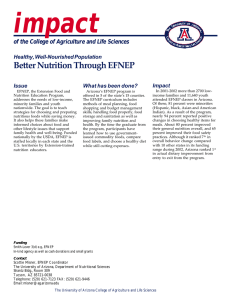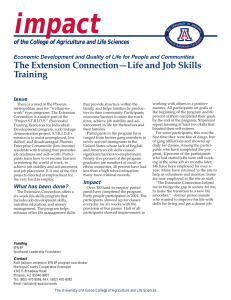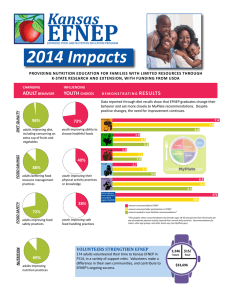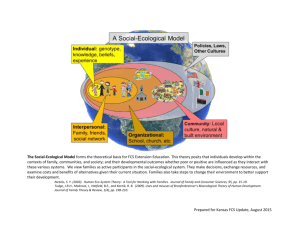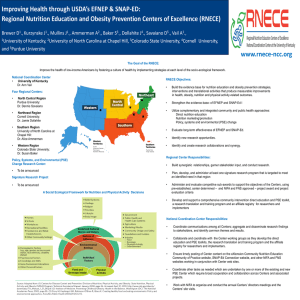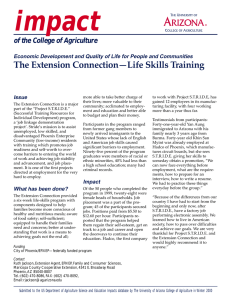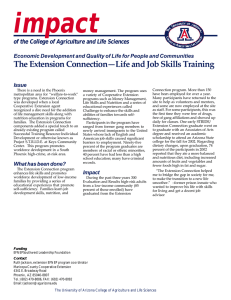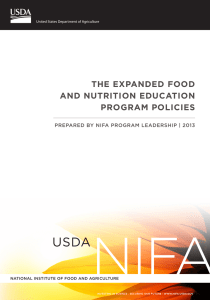S 2012 impacts: THE ExPaNDED FOOD aND NUTRITION EDUcaTION PROGRaM (EFNEP)
advertisement
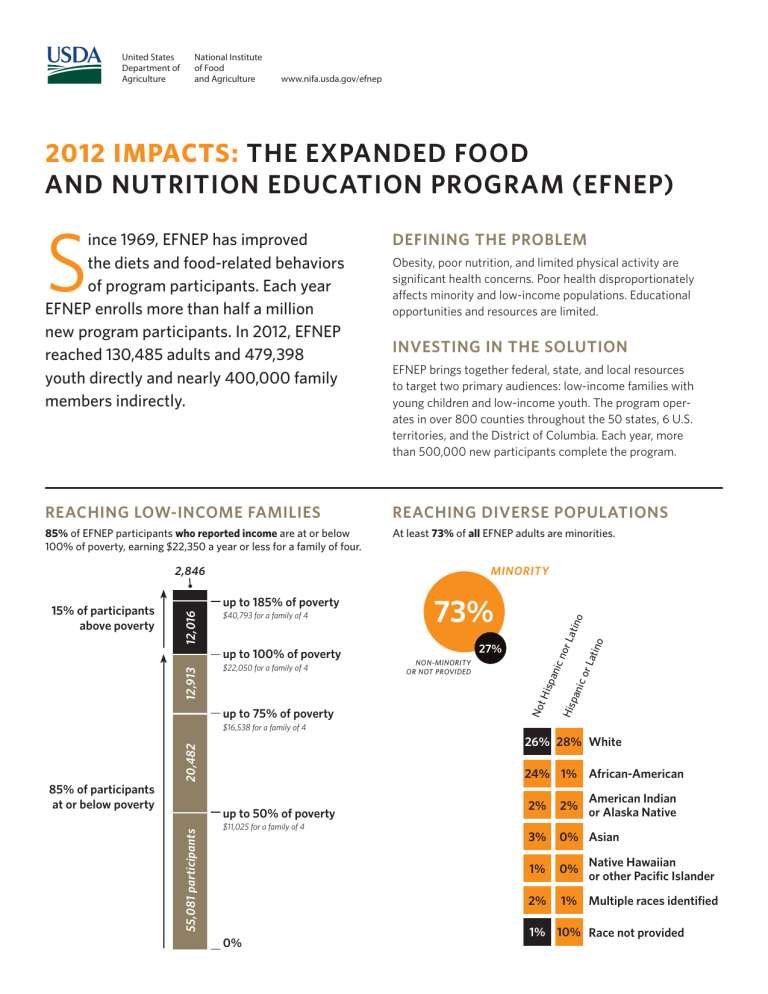
United States Department of Agriculture National Institute of Food and Agriculture www.nifa.usda.gov/efnep 2012 impacts: The Expanded Food and Nutrition Education Program (EFNEP) S ince 1969, EFNEP has improved the diets and food-related behaviors of program participants. Each year EFNEP enrolls more than half a million new program participants. In 2012, EFNEP reached 130,485 adults and 479,398 youth directly and nearly 400,000 family members indirectly. DEFINING THE PROBLEM reaching low-income families reaching diverse populations 85% of EFNEP participants who reported income are at or below 100% of poverty, earning $22,350 a year or less for a family of four. At least 73% of all EFNEP adults are minorities. Obesity, poor nutrition, and limited physical activity are significant health concerns. Poor health disproportionately affects minority and low-income populations. Educational opportunities and resources are limited. INVESTING IN THE SOLUTION EFNEP brings together federal, state, and local resources to target two primary audiences: low-income families with young children and low-income youth. The program operates in over 800 counties throughout the 50 states, 6 U.S. territories, and the District of Columbia. Each year, more than 500,000 new participants complete the program. minority o atin up to 75% of poverty r La tino or L ic n 27% pan non-minority or not provided His $22,050 for a family of 4 Not 12,913 up to 100% of poverty 73% pan $40,793 for a family of 4 His up to 185% of poverty 12,016 15% of participants above poverty ic o 2,846 $16,538 for a family of 4 20,482 24% 1% African-American up to 50% of poverty 55,081 participants 85% of participants at or below poverty 26% 28% White $11,025 for a family of 4 0% American Indian or Alaska Native 2% 2% 3% 0% Asian 1% 0% 2% 1% Multiple races identified Native Hawaiian or other Pacific Islander 1% 10% Race not provided An EFNEP graduate reported that before she started the nutrition classes she was very depressed because of her weight and health issues. After completing EFNEP, she lost a total of 19 lbs. and felt more energetic. In addition, she was able to reduce her blood pressure medications. After implementing what she learned in class with her family, her daughter went from a size 13 to a size 9 and her husband lost a total of 12 lbs. She stated, “I’m very happy because I got a job at a hotel where I’m in charge of breakfast. I am using the recipes from the food demonstrations in class and the clients love them. I’m implementing what I learned and I’m proud of my [EFNEP graduation] certificate.” — Texas EFNEP diet quality Changing Adult Behavior Influencing Youth A legally blind married couple saved $200 a month by cooking at home and avoiding processed foods and take out. Both learned basic cooking skills and basic nutrition through the exceptional instruction of the EFNEP paraprofessional. The couple purchased an electric skillet with a Braille control knob to continue making the recipes they learned. They make eggs for breakfast instead of eating packaged breakfast bars and homemade stew is their new favorite dish. — Wyoming EFNEP demonstrating results improvement in food groups 95% 63% Data reported through diet recalls show that EFNEP graduates eat more closely to MyPlate recommendations. It also shows there is still a huge need for nutrition education. 5.7 5.5 grains Percentage of adults improving diet, including consuming an extra cup of fruits and vegetables nutrition When I arrived to teach nutrition, the kids were always eating candy and drinking soda from the snack bar. I talked with the staff and the Director about it and eventually a few nutritious items were added, but the candy always sold first. After going over label reading, we took the youth shopping. They were amazed at the high sodium, sugar, and fat of snack bar items. They, by themselves, eliminated items from the list because they weren’t nutritious. They voted to make the snack bar a candy/soda free zone and the Director supported it. These young people are making healthy choices and developing healthy habits. — Peer Educator, Alaska EFNEP Percentage of 140,572 youth now eating a variety of foods in ounces 1.4 vegetables in cups 0.8 fruit dairy in cups 90% Percentage of adults improving nutrition practices 65% Percentage of 171,274 youth increasing essential human nutrition knowledge 2.5 1.3 in cups 1.2 1.7 2.0 1.5 3.0 5.0 5.1 meat in ounces 0% 6.0 50% 5.5 100% amount consumed before EFNEP amount consumed after participation in EFNEP food safety food savings amount needed to meet MyPlate recommendations* * This graphic shows recommendations for females ages 19-30 who get less than 30 minutes per day of moderate physical activity, beyond their normal daily activities. Recommendations for males, other age groups, and other activity levels vary (see MyPlate.gov). 85% Percentage of adults bettering food resource management practices 62% Percentage of 126,334 youth increasing ability to select low-cost, nutritious foods whY it works EFNEP educators follow a research-based learning model that allows them to effectively reach and educate program participants. Educators are • members of the communities they support; • trained/supervised by university and county-based faculty; • skilled in using hands-on, interactive teaching methods; • committed to delivering sound instruction; 66% Percentage of adults improving food safety practices 59% Percentage of 148,746 youth improving food safety and preparation practices • able to influence changes in behavior and impact the lives of those they teach; and • dedicated to reaching diverse, low-income populations. For more information, visit www.nifa.usda.gov/efnep or contact sblake@nifa.usda.gov or hchipman@nifa.usda.gov | USDA is an equal opportunity provider and employer | Revised March 2013
